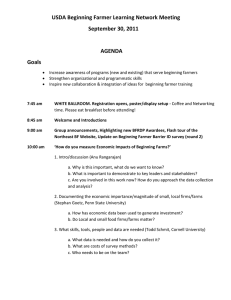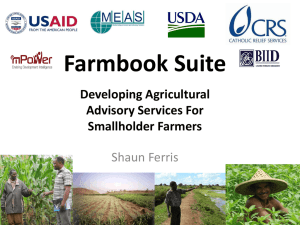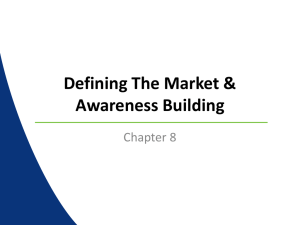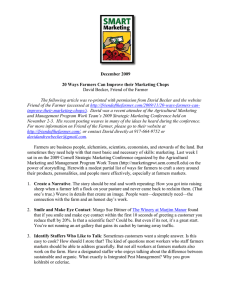14.74 Foundations of Development Policy
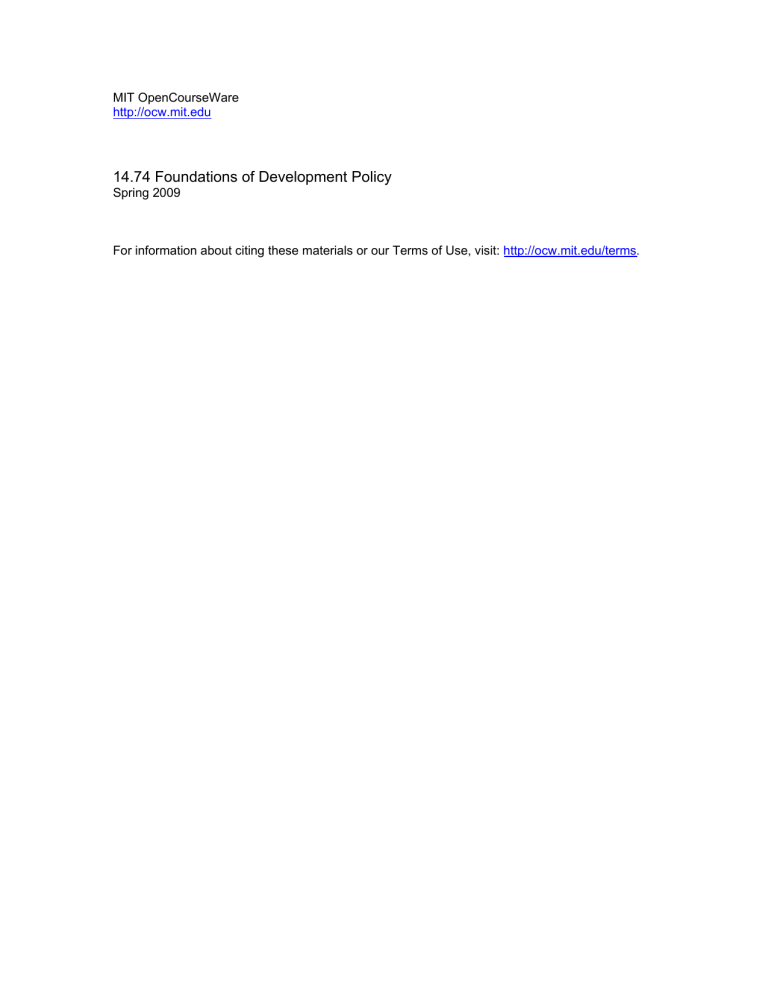
MIT OpenCourseWare http://ocw.mit.edu
14.74 Foundations of Development Policy
Spring 2009
For information about citing these materials or our Terms of Use, visit: http://ocw.mit.edu/terms.
Problem Set #5 – Models of Insurance and Credit
14.74
Due by 5 pm on Monday, May 4 th
You may turn it in during class or to Leila’s mail folder on the 3 rd floor of E52.
1.
Insurance and Incentives
Consider a village of a large number of identical farmers. All farmers are ownercultivators; i.e., they own and work their own land. They can choose how much effort p to apply to their land, where p is either p
L or p
H
( p
L
< p
H
). With probability p their crop is a success, and their output is H ; with probability (1-p) their crop is a failure, and their output is L<H . For consumption equal to y , utility over consumption and effort is given by u(y) – C(p) . C(p) is the cost of effort; assume that
C(p
L
) = 0 and C(p
H
) = K , a positive constant. Farmers are risk-averse. a.
Assume there is no insurance. What condition must be satisfied for farmers to choose effort level p
H
? For the remainder of this problem, assume that this condition is satisfied. What is each farmer’s expected consumption under this choice of effort? What is their expected utility? b.
What does risk-aversion imply about the shape of u ? Explain why we interpret this condition on u as risk-aversion. c.
Suppose now that the farmers form a group insurance mechanism. Assume that each farmer’s effort level is observable to all other farmers. Consider a full insurance mechanism which requires that each farmer choose effort p
H
, all farmers pool their output, and then each farmer gets an equal, nonrandom share. i.
Is such a mechanism feasible? Explain why? (Hint: There are two conditions that must be satisfied; all farmers must choose p
H and their consumption must be nonrandom). ii.
What is each farmer’s expected consumption under this mechanism? How does this compare with expected consumption in (a)? iii. What is each farmer’s expected utility under this mechanism? How does this compare with the expected utility in (a)? iv.
Explain the reason for the difference in your answers to parts (ii) and (iii). d.
Now suppose that each farmer’s choice of effort level is unobservable . Is the mechanism in part (c) still feasible? Why or why not? e.
We continue to assume that each farmer’s choice of effort level is unobservable.
We will now solve for the optimal, feasible insurance mechanism. Consider the following mechanism: After output is produced, all farmers pool their output. If a farmer’s output was H , he gets to consume h ; if his output was L , he gets to consume l . In the case of full insurance, h=l . i.
What “budget constraint” must be satisfied to ensure that the total insurance payments made equals the total amount taken in? ii.
What condition must be satisfied to ensure that all farmers choose p
H
? Does this condition hold in the case of full insurance, and why? iii.
What is each farmer’s expected consumption from this insurance mechanism?
iv. Argue from (i)-(iii) that L<l<h<H . Argue also that expected utility under this mechanism is greater than expected utility under no insurance (i.e., part
(a)) but lower than expected utility under full insurance (i.e., part (c)). f.
Suppose L=1 (i.e., the number one, not lower-case “L”) and u(y) = ln(y) . i.
Calculate the optimal h and l based on part (e). ii.
Show that farmers face less variation in consumption than in the no insurance case, but more variation than in the full insurance case (for this, show algebraically that the amount l > 1 (one) and h < H).
2.
Credit as Insurance
Read the following article in your syllabus (this article is posted on course website ):
Christopher Udry (1990), “Credit Markets in Northern Nigeria: Credit as Insurance in a Rural Economy,” World Bank Economic Review 4(3), 251-269.
For each part below, please limit your response to about one paragraph (the entire question should take about a page). Do not summarize the article; please answer specifically and precisely the questions asked. a.
In the Nigerian villages that Udry studies, there is active borrowing and lending within villages and within kinship groups. How does Udry demonstrate that there are risk-sharing arrangements between borrowers and lenders? Please refer to specific results in tables to support your answer. b.
Someone might argue that Udry’s empirical results are due to limited liability
(which leads to sharecropping arrangements between borrowers and lenders). In what way would this person be right? Why can’t this person’s explanation fully account for Udry’s empirical results? Please refer to specific results in the tables to support your answer. c.
Relate Udry’s findings to lecture regarding the difficulty of enforcement: how can
Udry’s findings explain why it is often not economically feasible for formal institutions to lend to, or provide insurance for, poor, rural households? Even though informal insurance mechanisms may exist and operate well, what is a limitation that they have which formal institutions could improve upon?
